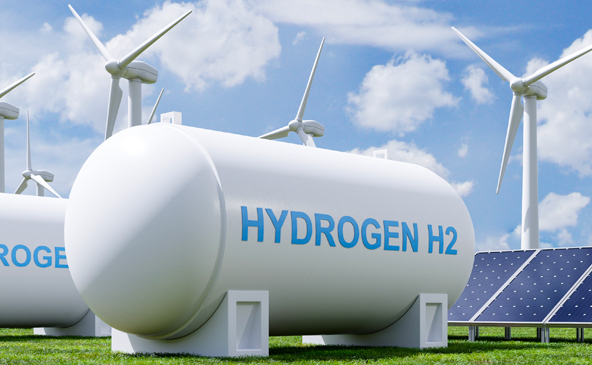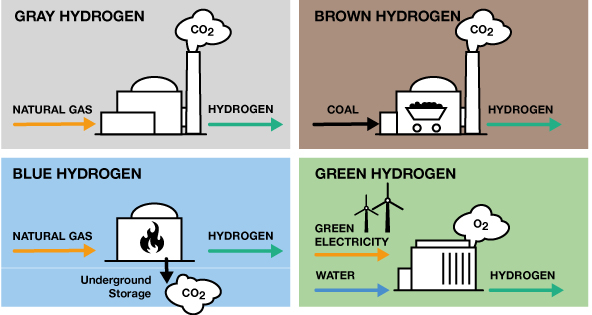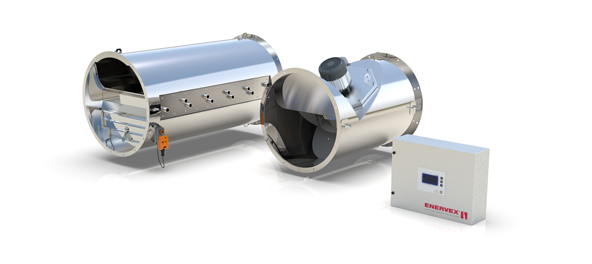
Given the challenges and environmental impacts associated with fossil fuels like oil, gas, and propane, the HVAC industry is exploring cleaner alternatives, such as hydrogen and electric systems. Is hydrogen or electric heating the superior choice for the future?
The Problems with Oil, Gas, and Propane
In the United States, 59% of residential heating and cooling systems operate on fossil fuels such as oil, gas, or propane. Natural gas is by far the most popular – supplying 63 million or 51% of US households. Heating oil and propane are each used in around 4% of households. Despite their widespread use, these sources of energy are problematic.
From an environmental perspective, all three are a significant source of CO2 emissions. Although natural gas is still a fossil fuel, it is preferable because it is up to 40% cleaner than heating oil or propane. It also produces fewer harmful pollutants, such as sulfur dioxide and particulate matter. The environmental footprint of oil, gas, and propane extends beyond their combustion in our homes. The entire lifecycle of these fuels – from drilling and extraction to refining and transportation – incurs significant ecological and energy costs.
The issues with gas and oil extend into two other pressing areas – safety and price volatility. Explosions and oil leaks put consumers and the environment at risk. Meanwhile, geopolitical tensions and fluctuating demand contribute to unpredictable fuel prices, making it difficult for businesses to plan and for consumers to manage their budgets.
Electric as a Costly Alternative
The HVAC industry has turned to electricity as a promising alternative, drawn by its potential to be generated from renewable energy sources such as solar, wind, hydroelectric, and geothermal power. This is theoretically sound, offering a path to greener operations, but the practical implementation of electric HVAC systems is complicated.

While electric boilers do not emit greenhouse gases at the point of use, the production of electricity in fossil fuel-powered plants does.
The overall environmental friendliness of electric heating significantly depends on the mix of energy sources used to generate electricity. As of 2022, 60% of electricity generation is still created through fossil fuels.
Complete System Replacement and Infrastructure
Upgrades Needed Shifting from traditional oil or gas heating to an electric HVAC setup involves a complete system replacement, not just a simple retrofit. The existing oil or gas boiler or water heater must be removed to install a new electric system, including electric boilers or heat pumps. Given the extensive changes needed, including potential upgrades to electrical panels, wiring, and the heating distribution system itself – this process involves a large financial investment. For many households and businesses, this cost can be prohibitively expensive.
Beyond the immediate costs of system replacement, there are broader infrastructure concerns. Many buildings, especially older ones, may not have electrical systems that can support the high demand of electric heating. Upgrading these systems to handle increased electrical loads adds complexity and expense.
On a larger scale, if many buildings in a region make the switch to electric heating, this could place additional strain on the electrical grid. Ensuring the grid's capacity to handle peak demands during cold periods without compromising grid stability requires substantial planning and investment in grid infrastructure and capacity improvements.
Can Hydrogen Replace Gas and Electricity for HVAC?
Hydrogen is starting to catch the eye of the HVAC industry as an eco-friendly choice for heating and cooling. Big names like Bosch are diving into the hydrogen scene, exploring how it can kickstart a shift towards cleaner, more efficient energy use in our homes and buildings. Its unique attributes and compatibility with existing infrastructure present a different set of advantages and challenges compared to fully electric solutions.
Advantages of Hydrogen over Electric HVAC
-
Simpler Retrofits
Unlike electric systems, which often require a complete overhaul of existing heating infrastructure, hydrogen fuel can utilize much of the existing natural gas heating systems. This mitigates much of the financial concerns associated with electric replacements.
In fact, utilizing hydrogen blends in boilers is not a novel concept, and the industry has been implementing this practice for many years. For instance, a chemical facility in Texas has successfully operated a boiler on a blend of natural gas and approximately 8.5% hydrogen for over a decade and a half. This experience has equipped the sector with valuable insights into managing hydrogen's distinct properties compared to natural gas.
Hydrogen boilers would be very similar to conventional gas boilers but designed to combust hydrogen to generate heat. Instead of emitting carbon dioxide, the only emission would be water vapor. As long as the hydrogen is produced from renewable sources, this makes for a far more environmentally friendly option.
-
Reduced Grid Pressure
In many areas, the existing electrical grid is old and outdated, operating near or at its capacity during peak demand periods. The DOE, under President Biden, is investing billions toward grid infrastructure improvements to reduce power outages and other instability issues. Widespread adoption of electric heating could increase winter peak electricity demand by up to 40% in colder regions of the U.S. Hydrogen heating systems do not add to the electrical grid's load, circumventing some of the investments and upgrades required to support other electrification efforts like electric vehicles.
-
Environmental Production Methods
Hydrogen can be produced in several ways, including more environmentally friendly options like electrolysis and thermochemical processes. This "green hydrogen" has the potential to offer a heating solution that's not only zero-emission at the point of use but also sustainable from production to consumption.
Here’s a quick overview of some of the pros and cons of different hydrogen production methods:
- Steam Methane Reforming (SMR) – This cost-effective approach (0.75 USD per kg) reacts methane with steam under high temperatures, producing hydrogen and CO2. Its downside is the significant CO2 output, making it less green unless coupled with carbon capture technologies.
- Electrolysis – Electricity splits water into hydrogen and oxygen, creating pure hydrogen without CO2 emissions. While this method is cleaner, it's also pricier (2.6 to 3 USD per kg) due to electricity and equipment costs.
- Thermochemical Processes – High temperatures induce chemical reactions to generate hydrogen from water or biomass. Still, in developmental stages, it's not widely commercial but offers potential for efficiency and renewable energy use.

Hydrogen Production Methods
Areas Where Hydrogen May Fall Short
-
Production and Distribution
Efficiency While hydrogen does not directly stress the electrical grid, the efficiency of its production is currently lower than direct electrical transmission. Electrolysis efficiency currently ranges from 60% to 80%. This means if 100 units of renewable electricity are used in electrolysis – only 60 to 80 units of that energy are stored as hydrogen. When this hydrogen is converted back to heat in a building, additional losses occur.
Direct electrical transmission to heat pumps can achieve efficiencies of 300% (or a Coefficient of Performance of 3.0), meaning that for every unit of electrical energy used, three units of heat energy are produced. Hydrogen production and distribution must improve to compete with electricity on a large scale.
-
Cost and Availability of Green Hydrogen
Right now, the cheapest way to make hydrogen is through steam methane reforming (SMR), but it's green hydrogen. The other readily available method comes from splitting water into hydrogen and oxygen using electricity in a process called electrolysis. This does generate green hydrogen, however it’s 3 to 4 times more expensive SMR because of equipment and electricity costs.
The Colors of Hydrogen

In order for hydrogen to become a more mainstream and affordable fuel source, advancements are needed in cost-effective and green production methods. Thankfully, lower cost electrolyzers are becoming available and the supply chain is improving.
Thermochemical hydrogen production, which uses sustainable biomass or solar energy, presents a promising option. With further research and development, these processes could become commercially viable. This would provide a substantial supply of cheap green hydrogen that does not utilize the electrical grid in a large-scale way.
-
Infrastructure Development
Despite the potential for simpler retrofits, the widespread adoption of hydrogen heating still requires substantial development of hydrogen production, storage, and distribution infrastructure. This includes establishing hydrogen refueling stations and retrofitting gas networks to handle hydrogen safely.
Hydrogen has a lower BTU value than gas, meaning about 5x more hydrogen is needed to reach the same heating value as natural gas. Effective storage solutions must focus on compactness and efficiency to address this disparity. One approach involves solid-state hydrogen storage, which allows hydrogen to be stored at lower pressures, reducing the volume needed.
Energy Efficiency and Waste Heat Recovery
As mentioned before, hydrogen struggles to compete with electricity from an energy efficiency standpoint. Waste heat recovery (WHR) can help the HVAC industry bridge this gap. WHR systems can capture unused heat from a building to reheat water entering a hydrogen-powered boiler or support other heating needs. This can effectively reduce the overall amount of hydrogen fuel needed to reach the desired temperatures.
WHR can also enhance the hydrogen production process itself by reclaiming heat from electrolysis and other hydrogen-generating methods. By capturing and reusing this thermal energy creates a positive feedback loop that can significantly reduce the energy input required for hydrogen production.
Advancing the Hydrogen Economy – Global Initiatives and Strategies
The future of hydrogen fuel is bright, but largely depends on investment in hydrogen initiatives, to bring this technology to maturity. Several countries are conducting pilot projects to test the feasibility and efficiency of hydrogen heating systems in residential and commercial settings. Here are some of the current initiatives from around the world:
- U.S. National Clean Hydrogen Strategy and Roadmap (June 2023) – Aims to bolster clean hydrogen across production, storage, and usage sectors.
- National Green Hydrogen Mission – With a budget of $2.3 billion from 2022 to 2030, India is focusing its efforts on enhancing green hydrogen production and consumption to support their clean energy goals.
- Regional Clean Hydrogen Hubs Program – Supported by President Biden's Bipartisan Infrastructure Law, this initiative includes $7 billion for the construction of 6 to 10 clean hydrogen hubs around the United States.
- § 45V tax credit – Part of the Inflation Reduction Act of 2022, this offers up to $3 per kilogram tax credit for low-emission hydrogen projects.
- EU Hydrogen Strategy – Details 20 actions across five key areas to integrate hydrogen fuel within the EU's energy matrix.
ENERVEX is Ready for Hydrogen
While hydrogen isn’t quite here yet, on a large commercial scale ENERVEX is ready. We are prepared to offer seamless retrofit solutions for businesses that choose hydrogen over electricity. When the time is here, we can help your business switch to this cleaner energy without needing to overhaul their entire electrical infrastructure.

ENERVEX also offers a Waste Heat Recovery System (WHRS) that can recovery waste heat as part of a larger hydrogen heating installation, to further improve the efficiency of hydrogen fuel.



